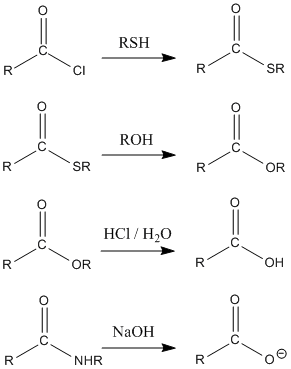
Reactivity in Chemistry
Substitution at Carboxyloids
CX2. General Reactivity Patterns
Just as a simple carbonyl is an electrophile, so is a carboxyloid. Carboxyloids react with many of the same nucleophiles that react with aldehydes and ketones. The overall result of the reaction is very different. However, the mechanism of the reaction is really quite similar.
Nucleophiles have the overall effect of adding across the carbonyl group of an aldehyde or ketone. Addition of a proton produces an alcohol. The C=O bond is parlty broken to a C-O bond. In some cases, the C=O bond is completely broken and after several steps the carbonyl oxygen is replaced by some other heteroatom. On the other hand, nucleophiles add to carboxyloids and end up replacing the heteroatom next to the carbonyl. The carbonyl itself remains intact after the reaction is complete.
The general pattern in carboxyloid chemistry is for nucleophiles to substitute for the heteroatomic group next to the carbonyl. In these reactions, the group next to the carbonyl is sometimes referred to as a "leaving group". That term simply means that this group has been replaced by the end of the reaction.

Figure CX2.1. Some substitution reactions of carboxyloids.
Note that there is no reason to believe that the initial elementary reaction between a carboxyloid and a nucleophile is any different than that of a simple carbonyl with a nucleophile. An examination of the frontier orbitals in a carboxyloid suggests the pi antibonding level would be the site of population by a nucleophilic lone pair. The carbonyl pi bond would break as the nucleophile approaches.
However, an important feature of carbonyl chemistry is that two heteroatoms on one tetrahedral carbon often don't last. One atom with lone pairs pushes the other off. There are exceptions, such as the chlorines in dichloromethane, CH2Cl2, or the O-C-O linkage in an acetal. However, even acetal linkages only form reversibly. One oxygen can easily push the other off to form a carbonyl structure again.
If a nucleophile does add to the C=O bond of a carboxyloid, the lone pair on the former carbonyl oxygen, now an anion, can bounce to push off the nucleophile. Then the system returns to the starting materials. However, if the former carbonyl oxygen displaces the heteroatomic group next to it, there is an overall change in bonding and a different product is formed. The net result is replacement of the group next to the carbonyl.
Problem CX2.1.
The overall result of reaction with a carboxyloid is to displace the heteroatom group next to the carbonyl. This group is typically liberated as an anion.
a) What feature of the heteroatoms typically found attached to the carbonyl in carboxyloids allows them to be displaced from the molecule as anions?
b) Why doesn't this same reaction happen with aldehydes and ketones?
Problem CX2.2.
Suggest an order of reactivity for the carboxyloids: rank them from most reactive to least reactive. Provide a reason for your trend.
Problem CX2.3.
For the following reactions
a. Draw mechanistic arrows for the nucleophilic addition. Clearly show the
tetrahedral structure formed immediately after the nucleophile adds.
b.
Determine if a leaving group is present. If so, show the pi donation step and
resulting product. If not, draw the product in the neutral form.

Problem CX2.4.
When acidic compounds such as HCl are produced in a reaction, the reaction is often followed by treatment with a base that will neutralise the acid. Provide Lewis-Kekule structures of the following bases.
a) lithium hydroxide, LiOH b) sodium hydroxide, NaOH c) potassium hydroxide, KOH
d) sodium bicarbonate, NaHCO3 e) sodium carbonate, Na2CO3 f) sodium acetate CH3CO2Na
g) sodium dihydrogen phosphate, NaH2PO4 h) sodium hydrogen phosphate, Na2HPO4 i) sodium phosphate, Na3PO4
j) pyridine, C5H5N k) triethylamine, (CH3CH2)3N
This site was written by Chris P. Schaller, Ph.D., College of Saint Benedict / Saint John's University (retired) with other authors as noted on individual pages. It is freely available for educational use.

Structure & Reactivity in Organic, Biological and
Inorganic Chemistry by
Chris Schaller is licensed under a
Creative
Commons Attribution-NonCommercial 3.0 Unported License.
Send corrections to cschaller@csbsju.edu
This material is based upon work supported by the National Science Foundation under Grant No. 1043566.
Any opinions, findings, and conclusions or recommendations expressed in this material are those of the author(s) and do not necessarily reflect the views of the National Science Foundation.
Navigation:
Back to Carboxyl Substitution Index
Back to Web Materials on Structure & Reactivity in Chemistry